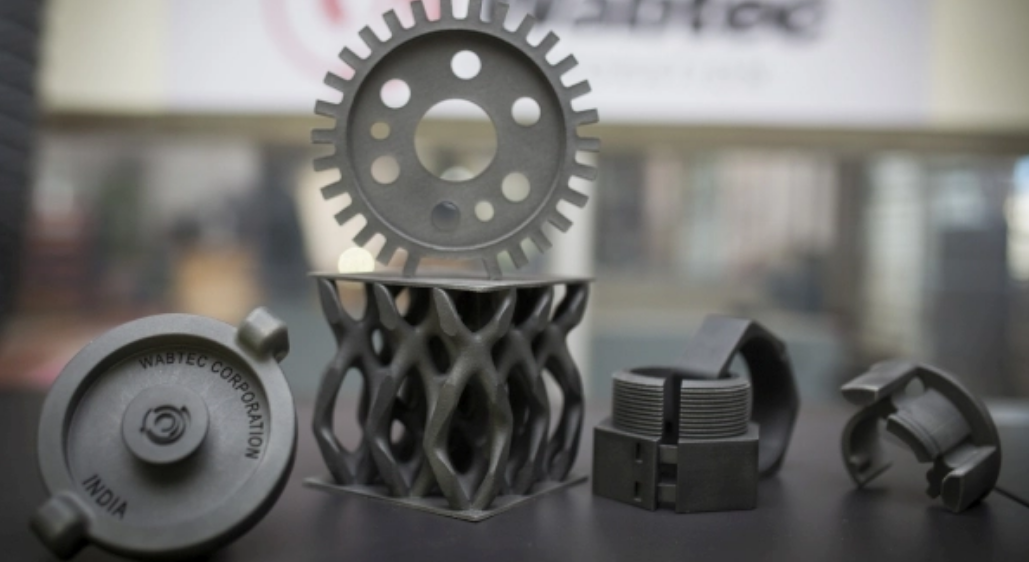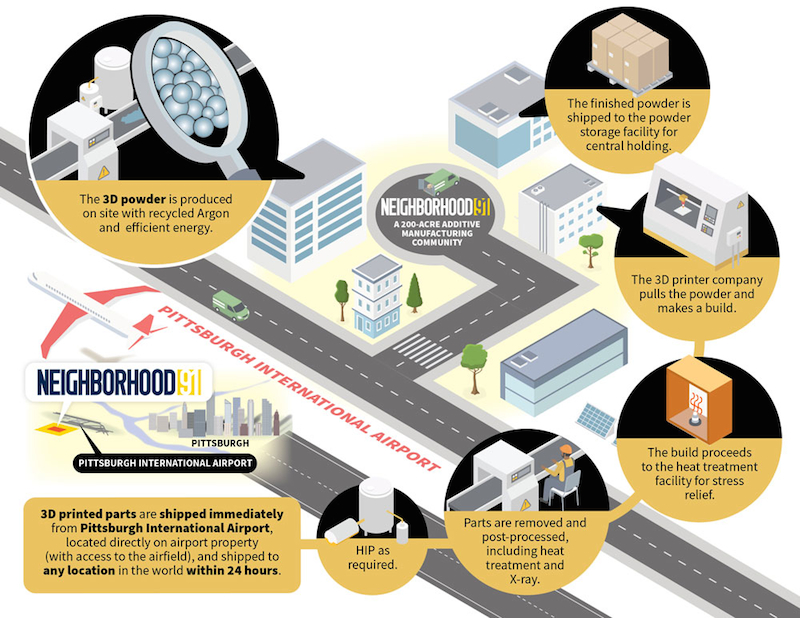Rail transportation is key to our global infrastructure and, in some ways, could be the future of that infrastructure in the face of climate collapse. For those reasons, it’s crucial that the rail industry stay ahead of the curve in terms of adopting new, potentially leaner manufacturing technologies. Among the businesses that is crucial to that industry adoption is the Wabtec Corporation, who has become an early adopter of 3D printing for the manufacturing of end parts for trains. To learn more, we spoke to Jennifer Coyne, Wabtec’s global additive manufacturing (AM) leader.
With a market cap of $13.96 billion, Wabtec (NYSE: WAB) is a maker of locomotives, as well as freight and passenger transit solutions. The firm has its roots in the Westinghouse Brake Company (WABCO), founded in 1869. After a long history as WABCO, Wabtec was eventually founded as its own company in 1999, with the merger of WABCO and MotivePower, and had its next big corporate move in 2019, when it merged with GE Transportation. As it enters a new era in rail manufacturing, Wabtec has begun producing locomotives with up to 4,000 horsepower (3 MW) and explores fully electric trains, as well.
Coyne, who was also featured recently on the 3DPOD, noted that 3D printing entered the picture in 2015-2016 as a prototyping technology, with metal AM becoming a part of the company’s strategy in 2017.
“That’s when we formed a team and started talking and thinking about production parts. I’ve been leading that team since that 2017 timeframe,” Coyne said. “It’s been kind of a gradual growth process, but also maybe a little bit faster than most, in that we’ve jumped in pretty aggressively on our investment and on building out the team and building out our labs to serve our internal businesses and also our customers.”
The team has labs in the Northwest Pennsylvania region, where the majority of Wabtec’s plastics and prototyping occur. In Grove City, the company focuses on steels and other metals using binder jetting and laser powder bed fusion (LPBF). In particular, Wabtec has become an early customer of GE Additive’s H1 binder jetting technology. The newest North American facility will be Neighborhood 91 in Pittsburgh, which will focus on delivering aluminum LPBF parts to transit customers. In Bangalore, India, Wabtec is using HP’s Multi Jet Fusion to 3D print industrial parts for customers, as well.

The components that will be 3D printed range from adapters and IOT shield covers for brake controllers to customised dispenser tips and sensor holders
Coyne may be understating Wabtec’s additive strategy by saying it is “pretty aggressive.” Compared to most industries, aside from possibly aerospace, the growth of 3D printing at Wabtec matches only GE itself. This makes sense since Coyne came from GE Transportation. With similar expectations for additive as GE has had, Wabtec has set a goal of 3D printing 25,000 parts by 2025. 2019 was the first year that the firm had production parts on trains. This came out to 1,200 individually printed copies of a variety of 12 different parts. Coyne said that prototype parts came out to a similar quantity.
To achieve this, Coyne says that she wants to gradually increase the number of serial parts produced with 3D printing. Last year, it was 12 unique production components. This year, it was bumped up to 25. The firm will then aim to double that number so that, by next year, the additive department at Wabtec will be “a well-established well-oiled machine so that we can really scale from there,” as Coyne puts it.
Obviously, COVID-19 has slowed nearly every industry down, but Coyne says that there are also some challenges in integrating GE Transportation with Wabtec in that she previously dealt only with freight and now, has to tackle transit, too. Additionally, the former business had customers mostly based in North America but has more located abroad with the Wabtec merger.
“At first, we had a lot of engine parts, where we were finding success—engine heat exchangers for instance—where our technology was changing more rapidly and where we had emission standards, for example, that would drive technology change,” Coyne said. “Now, fast forward when we have a more diverse portfolio and we have freight and transit, and we have expanded reasons to do additive. We have spare parts, which are even more of a concern for the transit, because they keep these transit vehicles operating for 40-plus years and spares end up being very unique assets because of that. So, spares are hard to come by in some of these because suppliers can be out of business, etc. And then they also care about lightweighting, which is something that the freight side of the house never did. So that’s another advantage where we find that additive actually brings a lot of value.”
Coyne was able to elaborate on the different value propositions 3D printing offers freight compared to transit. In freight, weight is actually necessary to keep the wheels on the rail so that it can pull harder and grip the rail. In turn, 3D printing has been improving production efficiency as well as the reliability of the engine, rather than lightweighting. The company was able to shrink the size of heat exchangers, while making them remove waste heat from the engine more efficiently and reliably. The benefits of using additive technology in serial production of parts for heat exchangers and turbochargers has been a reduction of lead times by 80 percent and inventory reductions by 75 to 80 percent.
In contrast, transit is more focused on reducing weight. Among the parts that are being influenced by 3D printing are pneumatic valves and components that feature a great deal of internal passages that would typically require a lot of machining and finishing. In preparing a part for transit trains, Wabtec was able to reduce weight by 75 percent, from seven kilograms down to two and a half.
Given the overall size of parts in the industry, Wabtec has had to begin investing in larger 3D printers, with Coyne saying that, initially, standard sized systems couldn’t produce big enough components. For that reason, at Neighborhood 91, Wabtec has an SLM 800 machine, one of the largest LPBF systems on the market.
Neighborhood 91 is itself an interesting project, in that it’s meant to be a complete 3D printing ecosystem. The site is located adjacent to the Pittsburgh airport, allowing for easy access to air transportation, and it features one business dedicated entirely to argon gas recycling and manufacturing at 60 percent of the typical cost. In turn, printed parts should be significantly cheaper to make, as well. Wabtec aims to be moved in by March of 2021 and will be one of the first anchor tenants for the neighborhood before others move in.
Wabtec is also a member of the Mobility Goes Additive organization in Europe, which has been so successful in the formalization of a 3D printing industry for rail that it has expanded to create a medical 3D printing network as well. According to Coyne, European adoption of 3D printing is very mature compared to the U.S., in part because additive has fit product lines better for transit than for freight. In particular, European companies seem to have a desire to perform lightweighting via part consolidation.
One large difference between the U.S. and Europe is the use of rail for transit overall, including long distance transportation. Proponents of a Green New Deal-style approach to making U.S. infrastructure more sustainable have advocated for the use of high-speed rail (HSR) in the country. When asked about the development of HSR in the U.S., Coyne suggested that rail transit will continue to evolve in urban areas, but less so for long-distance national travel.
“There is a difference in how we view public transportation and that’s because of the density of the United States versus Europe and APAC regions. It’s just, we have the challenge of bigger cities are further apart,” Coyne said. “My view is that we will continue to see more development and technology advancement in people movers within cities, but it’s not practical or economical to move people around the country with rail, as much as it is to move freight around the country with rail in the U.S. We just came out with a sustainability report, which talked about just the efficiency of rail versus the efficiency of trucking, for example, to move goods. It really makes a lot of sense when you talk about something like that, but when you’re talking about moving people, it will always look different here versus the rest of the world.”
Without understanding the economics, as well as the likely relationships between air and rail transport companies, oil giants, and members of the U.S. government, it does not seem completely out of the question to develop HSR in the U.S. After all, China has a larger total land area than the U.S. with large urban centers that are also spread out from one another, yet it has more HSR than any other nation. Andy Kunz, president of the U.S. High Speed Rail Association, suggested that it may be more an issue of oil interests thwarting HSR and public transportation in the country.
Even if HSR doesn’t become the long-distance solution for transit in the U.S., some environmental urban planners believe electrification to be crucial to a transition to renewable energy. In this regard, Wabtec has developed a 100 percent electric battery powered freight locomotive made up of 20,000 battery cells and featuring a trip optimization system that allows for optimizing energy distribution. In a pilot program taking place in Q1 of 2021, the battery locomotive will work with diesel locomotives in hybrid consist running on a 350-mile route across California’s San Joaquin valley.
Coyne isn’t sure if any 3D printed parts will end up on the next generation locomotive but says that her additive team has been instrumental in prototyping and design for the train’s FLX Drive engine. Given the potential for all-electric freight trains, this writer wouldn’t be surprised if at least a couple of 3D printed components make it onto some future version of the FLX Drive system. If that’s the case, we’ll hopefully have some more news on the project in the near future. Regardless, it’s exciting to know that Wabtec is invested in AM for the long haul.
Subscribe to Our Email Newsletter
Stay up-to-date on all the latest news from the 3D printing industry and receive information and offers from third party vendors.
You May Also Like
3D Printing News Briefs, April 13, 2024: Robotics, Orthotics, & Hypersonics
In 3D Printing News Briefs today, we’re focusing first on robotics, as Carnegie Mellon University’s new Robotics Innovation Center will house several community outreach programs, and Ugogo3D is now working...
Rail Giant Alstom Saves $15M with 3D Printing Automation Software 3D Spark
3D Spark has entered into a three-year deal with the rail giant Alstom. Alstom, a transport behemoth with annual revenues of $16 billion, specializes in the manufacture of trains, trams,...
Meltio Expands Global Reach with New Partnerships in the Americas and Europe
Spanish 3D printing manufacturer Meltio has expanded its sales network across the globe. With the addition of three new partners in the United States, Brazil, Argentina, and Italy, Meltio aims...
3D Printing Webinar and Event Roundup: April 7, 2024
Webinars and events in the 3D printing industry are picking back up this week! Sea-Air-Space is coming to Maryland, and SAE International is sponsoring a 3D Systems webinar about 3D...

































